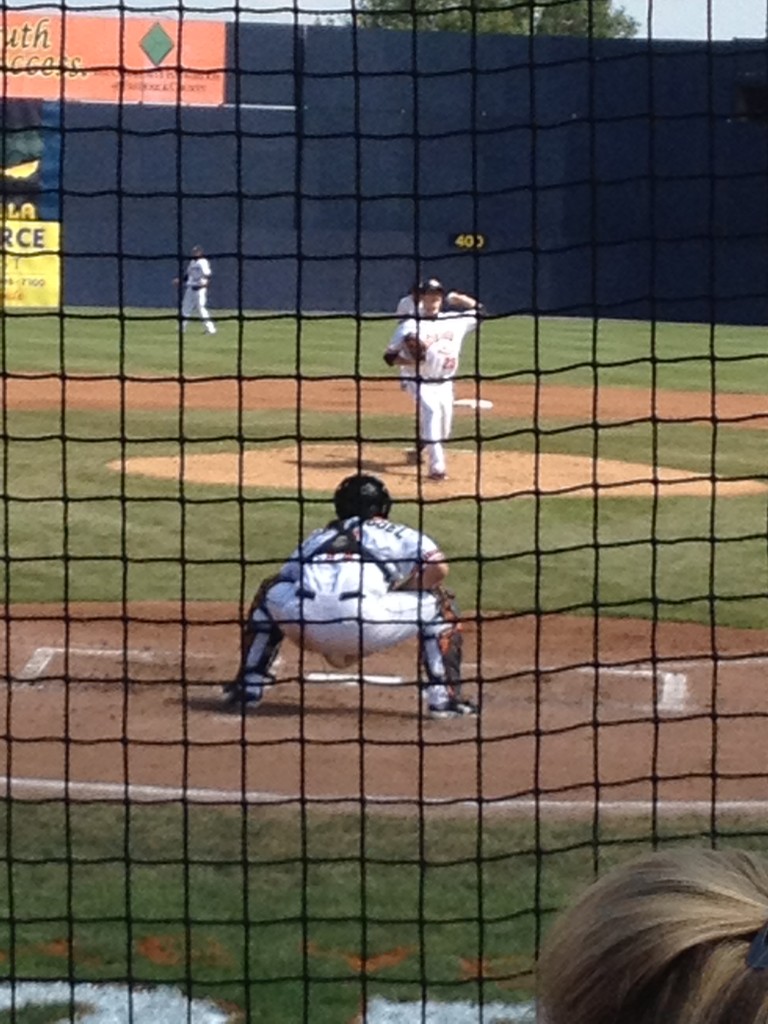Much like the masterful band Journey’s often overlooked second album, Looking Into The Future, I spent Labor Day weekend scouting the many talented prospects from the Frederick Keys and Potomac Nationals, the High-A affiliates of the Baltimore Orioles and Washington Nationals respectively.
Yesterday in Part 1 of this series, I examined Nationals pitching prospects Paul Demny and Brett Mooneyham along with rehabilitating Orioles infielder Ryan Flaherty; today in Part 2 I highlight two of my favorite overlooked prospects, Michael Taylor and Tim Berry, who are not receiving enough attention from others around baseball.
Michael Taylor CF Potomac Nationals
One of the best pure athletes in the organization, the still raw 22-year-old Taylor has started to turn his skills into performance this season for Potomac, hitting .263/.341/.428 with 10 home runs, 41 doubles, and 86 runs batted in. Taylor has quick hands, excellent bat speed, and has made a noticeable effort to stand taller at the plate this season to take advantage of this in order to make more solid contact.
Defensively, Taylor has made improvements this summer making reads on balls off the bat, which combined with his above-average speed and solid throwing arm make him an asset defensively in center field. He is also developing on the bases as well, stealing 51 bases this season in only 58 attempts.
The glaring weakness in Taylor’s game remains that he still strikes out far too often, specifically 128 times in 505 at-bats this season, and is particularly susceptible to high fastballs and off-speed pitches away. That said he has made noteworthy and commendable progress this season improving his all-around baseball skills, and has just begun to scratch the surface of his immense talent. Projecting a player to improve his ability to make contact is a risky proposition, but I see tangible signs Taylor is beginning “to get it”, and think he could be in store for a breakout season in 2014.
Tim Berry LHP Frederick Keys
Berry served as the starter for the Keys in their season finale Monday, and as he has done all season, he was impressive, pitching six innings and allowing three runs on seven hits and no walks and three strikeouts. Berry, 22-years-old, has an impressive repertoire consisting of a 90-94mph fastball, a 74-75mph curveball with some slurvy-type movement, and an above-average 80-81mph changeup with late downward action. A relatively skinny pitcher with projection remaining, Berry has a very quiet, clean motion and stays compact and square through his delivery.
Berry was recently selected as one of the Orioles prospects to play in the Arizona Fall League next month, which should provide an excellent challenge as he will face some of the best hitting prospects in baseball in an offensive-friendly environment. Berry likely starts next season in Double-A Bowie’s rotation, and as a lefty with three quality offerings, he has the potential to develop into a quality #4 or #5 starter in the big leagues, possibly as soon as mid-2015.
Right-handed reliever Brian Dupra entered the game in mop-up duty on Monday for Potomac and caught my eye with his potent arsenal comprising a 93-96mph fastball with some armside run, an 80-83mph slider that he can locate for strikes, and an 82-84mph changeup. A physically imposing figure on the mound at 6-3 200lbs, Dupra has been uneven at Potomac in 2013, posting a 4.96 ERA with 64 hits and 28 walks against 44 strikeouts in 61.2 innings pitched. Bluntly, his stuff is much better than those results, as his pure stuff should overwhelm A-ball hitters. Now almost 25-years-old, Dupra should receive a promotion to Double-A Harrisburg in 2014, and next season is critical to his career development path.
I am not particularly confident 23-year-old Potomac catcher Craig Manuel will ever develop into a professional caliber hitter, but he is quite proficient defensively, serving as a square, quiet target for the pitcher and shows an aptitude for blocking pitches in the dirt and throwing out potential base stealers. A left-handed hitter lacking power, Manuel does a reasonable job making contact and possesses a career .365 on-base percentage. If he can somehow manage to hit .240-.250 with a .310 OBP, his defense is good enough that he could find work as a major league backup in a few seasons.
A College World Series legend while attending South Carolina, right-handed pitcher Matt Price was the Orioles 7th round pick last summer; Price entered the game on Monday in the 9th inning to close out the victory for the Keys. Price possesses a huge, stocky physique and throws from a three-quarters arm slot with some effort in his delivery, which provides deception to the batter. Price throws an 89-92mph fastball with some late life and a 78mph slider that visibly fooled a hitter. An experienced 24-year-old pitcher, Price should start next season at Double-A Bowie and has a chance to reach the majors as a reliever particularly effective against righties.





